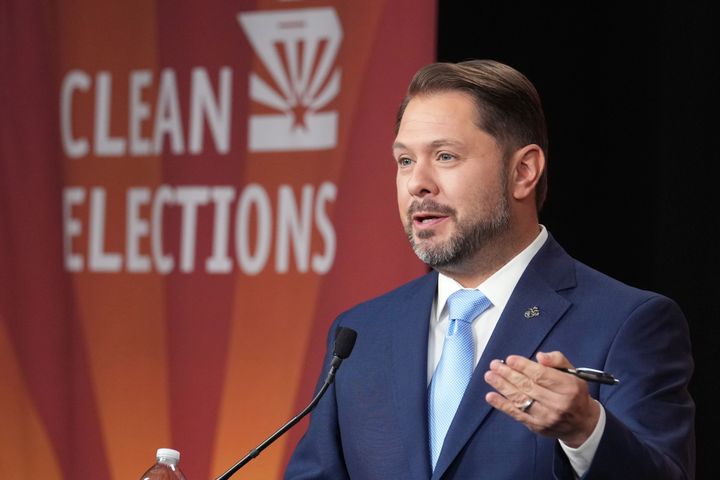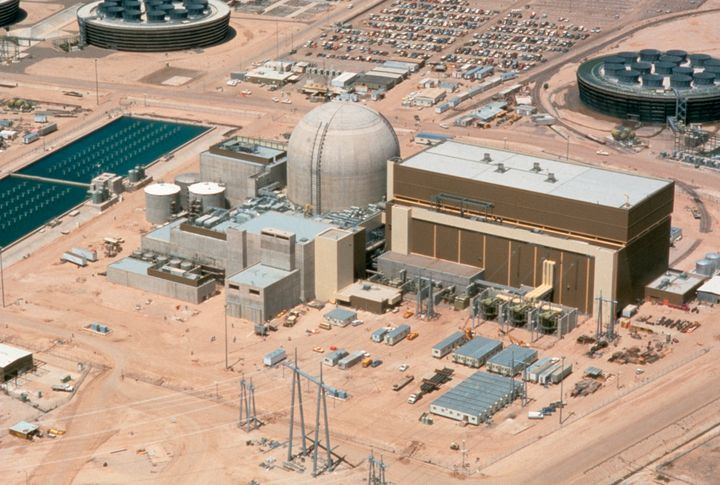Arizona just ended its hottest summer since records began in 1896, with its fast-growing Phoenix metropolis last month completing a historic 113-day streak of temperatures at 100 degrees Fahrenheit. The next few decades are forecast to be even hotter for longer.
To survive in that heat and keep the state’s economy growing, Democratic Senate candidate Ruben Gallego pitched one major solution at Wednesday night’s final debate with Republican rival Kari Lake.
More nuclear power.
Amid a combative televised parley in which the serving U.S. congressman attacked his GOP opponent for denying election results and climate science, Gallego said new reactors were the “quickest thing we could do to make sure we can continue the growth we have in Arizona with manufacturing and residential to make sure we can meet that.”
“We have to first accept that climate change is happening. We prepare for that by actually having a very resilient grid,” he said. “We need to bring in more baseload energy. That’s going to have to be nuclear.”

The term baseload refers to sources of electricity that can generate power nonstop, no matter the weather, in contrast to renewable energy sources like wind turbines and solar panels. While batteries have helped save renewable power for later, energy depletes in lithium-ion units over time, making long-term storage a challenge. As a result, the growth of wind and solar energy — the likes of which sun-soaked Arizona has in abundance and is increasingly tapping — has been accompanied by an uptick in natural gas to serve as a backup at night and when the air is still.
Aside from fossil fuels and nuclear power, hydroelectric dams and geothermal energy provide 24/7 output. But dams are ecologically destructive to vast areas, and water is growing scarcer, particularly in the American Southwest. While promising new breakthroughs suggest that geothermal energy could be harnessed in more places, it remains somewhat geographically limited to areas where the Earth’s crust is thin and there is a lot of volcanic activity, such as in Iceland or El Salvador.
Arizona already generates 27% of its electricity from its one nuclear power station. Located just west of Phoenix, the Palo Verde Generating Station is the nation’s second-largest nuclear plant. Its three reactors generate so much power the facility accounts for 4% of the generation by the United States’ entire fleet of 94 units spread out between 54 separate plants.
Nationwide public support for nuclear energy is at its highest level in more than a decade, with majorities of U.S. adults supporting new reactors in recent polls from Gallup and the Pew Research Center.
But 46% of Arizona’s power comes from natural gas, which produces potent planet-heating emissions from drilling and transportation even before it’s burned, spewing carbon dioxide into the atmosphere. And demand is growing.
The Grand Canyon State already consumes more electricity than two-thirds of other states, with the majority of Arizona homes using power for both heating and cooling. The state’s biggest power companies hit record demand in August as a heat wave drove temperatures in Phoenix to 116 degrees Fahrenheit and made energy-thirsty air conditioning essential. Cooling even a mid-sized home, The Wall Street Journal reported this week, drove up ratepayers’ bills to as much as $500 a month.

Arizonans needed more electricity to cool down right as the price of natural gas, the primary fuel for producing power in the state, spiked to its second-highest price in 35 years in July, behind only summer 2023’s peak, federal data show.
Even those who used the exact same amount of electricity saw an increase. In February, the Arizona Corporation Commission voted 4-1 to approve an 8% rate hike to allow utilities to “recover costs spent to maintain and upgrade the electric system.”
That hike followed other rate increases in 2019 and 2022, and could presage another in 2025, said Commissioner Anna Tovar, the lone dissenting vote this year.
“This is the most prominent rate increase customers have seen in quite a while,” she said in a local PBS station interview in August. “So they do have that sticker shock when it comes to, ‘Wow, how is my bill this high?’”
Tovar is the only Democrat on the five-member Commission.
That didn’t stop Lake from blaming Democrats for higher electricity prices.
“I was reading an article the other day of a woman who’s a retiree, she has to keep her house at 83. She keeps her windows and shades closed because she just can’t afford to cool her house,” Lake said, paraphrasing details from this week’s Journal story. “We need to bring the price of energy down.”
Her solution was light on specifics, largely echoing her party’s national catchphrases and promoting fossil fuel projects outside of Arizona.
“We need to bring back and start building the Keystone XL pipeline and continue, as President Trump says, to ‘drill, baby, drill,’” she said.

The Keystone XL pipeline, which President Joe Biden canceled in 2021, connects oil fields in Canada to another pipeline in the Upper Midwest. Last year, the U.S. eclipsed Saudi Arabia to become the world’s top producer of oil and beat out Russia and Qatar to take the top spot in exports of liquefied natural gas.
Without any known oil and gas reserves, Arizona is instead gearing up for a boom in mining copper and other minerals needed for the transition away from fossil fuels. In particular, Arizona has a long history of mining uranium, the metal used to fuel nuclear reactors, which is seeing spiking demand as the U.S. looks to wean off Russian imports.
Building new reactors, as Gallego wants, is no simple task. The U.S. has only started and finished two new reactors since the start of the century. Regulatory changes that took place in the 1990s, after much of the nation’s nuclear fleet was already built, make financing large-scale projects that cost billions of dollars and can take a decade almost impossible. Biden’s landmark climate and infrastructure laws directed billions of dollars toward boosting nuclear power, and surging demand from data centers is driving tech giants like Microsoft and Google into massive deals for atomic energy.
Electricity wasn’t Wednesday night’s only flashpoint.
“She didn’t bring up water,” Gallego said, raising his eyebrows. “This is Arizona. She should have brought up water. We need to make sure we make water investments to deal with the drought that’s caused by climate change.”
He promised to push for more federal funding for water reclamation projects, including covering canals. But he warned that upcoming water negotiations between the federal government and Western states like Arizona that depend on the dwindling Colorado River for freshwater supplies would likely lead to increased water cuts.
That “is going to be very dangerous to some of our farmers,” Gallego said. “They’re going to be shut off from that. These are the real things she should be doing. But she’s in denial about climate change, and we shouldn’t be surprised: She’s still in denial about the 2022 election.”
Lake, a former TV newscaster turned GOP hard-liner who has refused to accept the results of the gubernatorial election she lost two years ago, dismissed the issue outright.
“I’ve lived here for 30 years and I’ve watched as politicians continue to say we have a water crisis,” she said. “We need to look at long-term solutions. I’m not talking about fighting over a drop of water. We can conserve, but we can’t conserve our way out of this crisis.”
Her message doesn’t appear to be resonating. Despite Republican Donald Trump polling slightly ahead of Democratic rival Kamala Harris in the presidential contest in Arizona, surveys released over the past week show Gallego with anywhere from a 6- to 13-point lead over Lake.
Disclaimer: The copyright of this article belongs to the original author. Reposting this article is solely for the purpose of information dissemination and does not constitute any investment advice. If there is any infringement, please contact us immediately. We will make corrections or deletions as necessary. Thank you.
